|
Beach boats on England's
South Coast
by Gavin Atkin gmatkin@clara.net
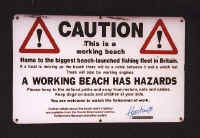 |
This sign isn't just a warning - it also let's you know
that Hastings is very proud of its fishing fleet, which is the largest
beach-based fishing fleet in Britain.
(click pictures to enlarge)
|
 |
Here it is perched on its steep shingle. The dark area
at the foot of the hill is a place called the Stade, which has a
distinctive collection of historic tall black-tarred net drying sheds.
Beyond it you may just be able to see Hastings' the famous funicular
railway. Well... fairly famous anyway. |
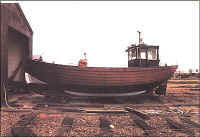 |
This is what I came to photograph. Here's a typical
example of one of Hastings' celebrated beach boats taken from the side.
Hastings' tubby, burdensome little fishing boats are traditionally
clinker built from larch using trenails to hold the structure together -
over the years it has been found that the slight flexibility that this
form of construction gives enables these boats to beach in surf
repeatedly without damage. Called beach punts locally, they aren't so
small really - some are as long as 26ft, and the modern steel and
fiberglass boats seem larger still. |
 |
Here's an end view.
|
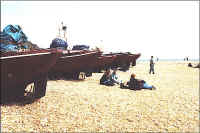 |
The sterns - either elliptical or lute types - are used
because they are said to help in launching. The elliptical sterns seen in
this picture seem to predominate in the remaining wooden fleet.
|
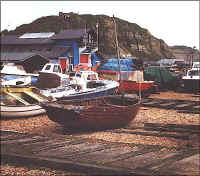 |
Wooden beach punts have not been built for
fifteen years of so (it's 2001 at the time of writing), but there are
still quite a few around, including some small ones. These have the
lute-type of stern.
|
 |
 |
Punts built from fibreglass have been popular for
fishing since larch became scarce. From time to time sailing folk people
buy a second-hand fiberglass beach boat and rig it with a standing or
balanced lug, and I gather they sail pretty well. I'm tempted to try it
myself. |
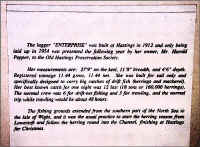 |
This series of photographs including the Enterprise,
a model of a Hastings lugger, and material about the tub-men, were taken
at a little museum devoted to the history of Hastings fishing community.
The note explains a lot, but it doesn't say that the last remaining
builder stopped making them only in the mid-1980s because supplies of
suitable larch could not be found. I suppose you could say that
fibreglass has proved to be a pretty good substitute.
|
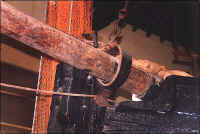 |
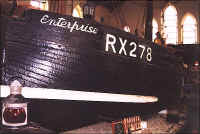 |
 |
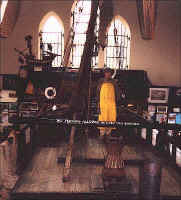 |
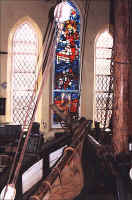 |
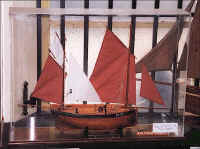 |
Notice the rounded bilges of these craft; the motorised
boats remaining in use today vary little, except that most have the
alternative elliptical stern whereas this one has a lute stern. This
model shows the kind of rig that was used. |
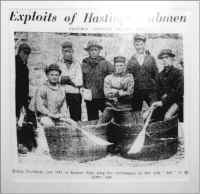 |
The Hastings tubmen were a phenomenon;
their game was paddling half barrels in the surf crashing onto Hastings'
steeply shelving beach and performing a variety of amusing stunts before
passing the bottle or hat round for money. A still sea was disdained by
the tubmen, apparently.
A favourite stunt seems to have been getting young women to sit in
the bottom of the barrel; with the extra ballast on board, the tubman
was able perform even more wildly. In my view, those of us who take an
interest in boats made from a single sheet of plywood have much to learn
from these heroes of the British seaside scene.
|
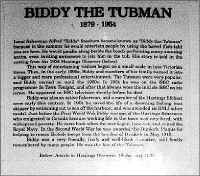 |
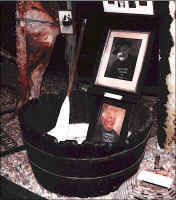 |
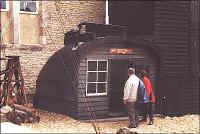 |
Proof that old punts need not die - they can become tea
shops, curiosity shops, shelters from the rain and...
|
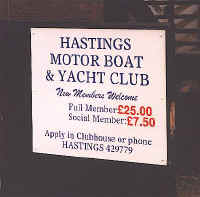 |
Finally, a stark reminder that Hastings is still a
hard-working town with few pretentions. This must be just about the
cheapest sailing club I've ever heard of!
|

|
People have been landing fat little beach boats along our coast for hundreds of years. These pictures (from Beer, in Devon)
show how it happens: the boat drives straight at the beach at amazing speed
while someone on the beach (a child of about nine in these pics) rushes down
the shingle bank with a cable. Then the boat is winched up the slope over
rollers.
( click to enlarge ) |
| The winches feature prominently in local life - a favourite annual competition involves posing while leaning on their housings, with marks
given for approach, solemnity of stance etc. I should have got a shot
dammit! but at the time I thought they looked like, well, boxes with cables
coming out. |

| The pictures below of giants, morris dancers and so on probably
don't belong here at all. Still, they might surprise those of you who
think that the Brits are either quiet, reserved people or lager-fuelled
drunken louts bent on giving Johnny Foreigner a hard time. Needless to
say, the people in these shots don't meet either description. |
 |
Here are some giants, which are always a feature of the Jack
in the Green. They are a revival of an old custom in the UK, but giants
are to be seen at festivals all over Europe.
|
 |
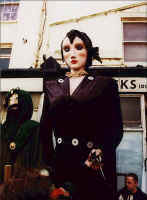 |
 |
Gordon Potts is a popular, almost hyperactive musician,
Morris dancer and caller, and a great chap for staying up late and
chatting with people. But it's the dance calling he does best - he's one
of my English ceilidh band favourite callers.
|
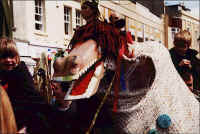 |
A couple of Morris dancers' hobby horses
|
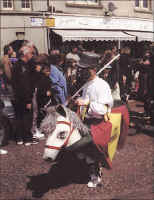 |
 |
Keith Leech is a great organiser and stalwart of both the
Jack in the Green festival, and one of the local Bonfire Societies.
Bonfire Societies? Many local settlements have them: think of what you may
have heard of Guy Fawkes night, and add few other local bogeys to the
pyre, add huge bonfires, and fantastic processions and fireworks displays
and you may be getting close to the events they run in October and
November each year... |
 |
Sue Graham is a champion among Morris dancers: in this
picture she is jumping over the stick she is holding for the third time -
without letting go! I can't believe she's only a few years younger than
me...
|
 |
This is me at Hastings' famouse Jack in the Green
celebrations held at the beginning of May each year. I've included this
shot because I thought you should know that the wild green men got me
too!
|

|
![]()